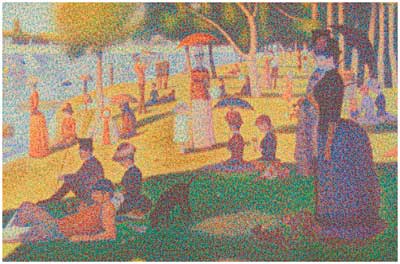Our minds have a limited capacity to comprehend really, really big numbers. At least mine does. A million tons of C02 might as well be a zillion. Twelve and a half million dollars spent every hour on the Iraq war might as well be bazillions.
Sometimes we try to fathom the enormities of raw numbers by visualizing them. How often have you heard that something stacked on end would extend to the moon and back?
But that never helps me. I can’t actually comprehend just how many pop cans, or human DNA particles, or safety pins, or Chevy engines, or hotdogs would get me to the moon. It’s just a heck of a lot.
Luckily for people like me, Seattle artist Chris Jordan has found a way to put big numbers into perspective.
Jordan’s large-scale photographs (click on “Running the Numbers” for the latest work) are as beautiful as they are disturbing. Each image portrays a specific quantity of some man-made consumer item—fifteen million sheets of office paper (five minutes’ worth of paper use in the U.S.); 106,000 aluminum cans (thirty seconds’ worth of U.S. consumption); 2.3 million folded prison uniforms (equal to the number of Americans incarcerated in 2005). Sometimes abstract, sometimes pictorial, and often clever twists on familiar images (like this take on a famous Seurat made out of a mosaic of 106,000 aluminum cans—the number used in the US every thirty seconds), Jordan’s photographs deal with pressing social concerns: criminal justice, prescription drug abuse, gun crimes, and overflowing landfills.
Take a closer look:
Zooming in even more, the Pointillsim of our times:
The photos speak for themselves—and speak to a nation burying itself in its own consumer waste. But, it’s also worth reading how Jordan describes his motivations for this project (click on “statement” on his website).
Really, to get the full, striking effect, these “American self-portraits” should be viewed in person—they’re appropriately vast—but check the website now and again because Jordan’s adding new images all the time.











comboverranch
The Chinese are competing to buy all our cardboard boxes, our newspaper, our pop and beer cans and most everything we throw away. We will eventually mine our land fills for them. I’m just hoping they’ll come for the four old cars I’ve got up in the pucker brush.
Anna
Chris Jordan was recently interviewed in Orion Magazine. Check it out here
Bobby P
How does a display of art reflecting the castoffs of a culture or lifestyle lead to meaningful change? How does it persuade? How does it influence? As Jordan says in the article … it’s one path of many to that ‘aha’ moment. What’s so disenheartening about such moments which assuredly DO exist, is that they’re so transient. So what’s the ‘glue’ that makes them stick and lead to another step down the road. Is it fear, compassion, revulsion, opportunity, idealism, security or what? After reading Jordan’s interview I still couldn’t put my finger clearly on his ‘glue’. And I’m surprised a bit by his self-criticism. Read the article and share your opinion.